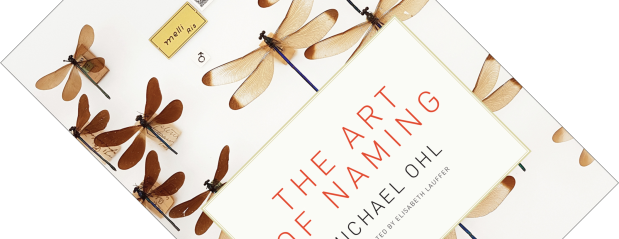In my review of Kemp’s The Lost Species: Great Expeditions in the Collections of Natural History Museums, I highlighted the importance of naming species and the rich vein of undiscovered species hiding in museum collections around the world. But how does the naming of species work? And what complications can arise? With The Art of Naming, Michael Ohl has written a surprisingly engaging book on the potentially stuffy topic of taxonomical nomenclature that beautifully complements Kemp’s work.

“The Art of Naming“, written by Michael Ohl, published by MIT Press in April 2018 (hardback, 294 pages)
This book was originally written in German as Die Kunst der Benennung and published in 2015 by Matthes & Seitz Berlin. It kicks off with the linguistics of vernacular species names (i.e. the common name of a species, so brown rat instead of Rattus norvegicus) specifically geared towards a German readership. Understandable given the book’s origins, but for an international audience this is a bit abstruse (although I thought the episode of Hitler interfering with a proposed name change of bats was amusing). When Ohl then proceeds to list all 150 common English names for African shrews that the authors of the encyclopaedic Mammals of Africa made up, I was getting a bit worried. Nomenclature is not necessarily the most riveting of topics, and taxonomists can be rather eccentric. Is this book going to be any good?
I need not have worried. In subsequent chapters Ohl branches out into a vast array of topics relevant to taxonomic nomenclature. Obviously, a book on this topic has to give a canned history of the binomial nomenclature formally introduced by the Swedish scientist Carl Linnaeus in 1753. Biologists around the world use his system of naming species to this day. However, Linnaeus merely laid the groundwork, and more and more rules had to be created to deal with all sorts of complexities and exceptions that can arise when naming millions of species. This led to the development of the International Code of Zoological Nomenclature in 1905, currently in its 4th edition, which is effectively a sleep-inducing legal document. Ohl masterfully distills relevant knowledge from this document. Whether you find the linguistic discussion of names-as-labels interesting is another thing, but it does explain how some names do not necessarily describe the characters of a species. And for the first time I encountered a clear explanation of what the differences are between for example syntypes, lectotypes and neotypes – designations I frequently encounter when reading summaries of technical literature.
“Authors have complete freedom when choosing names, which has led to all sorts of buffoonery”
A book on this topic of course cannot shy away from the silliness of some species names. This was already explored at length in The Naming of the Shrew: A Curious History of Latin Names. Authors have complete freedom when choosing names, which has led to all sorts of buffoonery. Whether it is raunchy references to genitalia (Probarbus labeamajor, a fish with big lips), nerdy nods to Lord of the Rings characters (Shireplitis frodoi, a wasp from New Zealand), or well-meant worshiping of celebrities (Heteropoda davidbowie, a spider) – it seems that spending hours staring down a microscope is not necessarily good for your mental health. Then there is the good-humoured use of scientific species names in works of speculative zoology, such as the recently reviewed After Man: A Zoology of the Future, or the doubtful status of species names assigned to non-existent cryptozoological creatures such as the Loch Ness monster. (Yes, it was formally described in a 1975 Nature paper!)
But Ohl also touches on more serious issues – for example the taxonomic vandalism that is committed by certain superproductive authors who describe thousands, sometimes tens of thousands of species in their lifetime. Are they geniuses or cranks? Few people have the resources to verify the prolific output of such experts, but it is not uncommon that their work leaves a field in taxonomic upheaval that can take decades to sort out (Benjamin Jones wrote a great long-read on Smithsonian.com on just this topic).
“the taxonomic vandalism that is committed by certain superproductive authors […] can leave a field in taxonomic upheaval that can take decades to sort out”
Similarly, how to exactly define what a species is is another contested issue. Despite decades of philosophising and debating, we still have no agreed upon definition (see for example The Species Problem: A Philosophical Analysis or Species Concepts in Biology: Historical Development, Theoretical Foundations and Practical Relevance), although in practice most biologists will settle for Ernst Mayr’s Biological Species Concept. When we deal with insects, the question of whether, say, Robineau-Desvoidy’s 248 described species of tachinid flies are all just colour morphs of one and the same species might seem like a whole lot of academic navelgazing. But when Colin P. Groves and Peter Grubb used different species concepts in their 2011 book Ungulate Taxonomy to argue that there were twice as many hoofed mammals as we thought, this suddenly has real-world implications where species conservation and earmarking of funds are concerned!
The Art of Naming describes many other fascinating topics and historical anecdotes not mentioned here. But rather than a rag-tag collection of vignettes, Ohl uses them to shine a light on the manifold rules and intricacies enshrined in the International Code of Zoological Nomenclature, and what this means for the day-to-day work of the biologists that describe and name species. MIT Press is to be congratulated on making this book available to an international audience as Ohl has written a surprisingly engaging work on a topic that many people might otherwise write off as dull.
Disclosure: The publisher provided a review copy of this book. The opinion expressed here is my own, however.

, hardback or ebook
Other recommended books mentioned in this review:
__________________________________________________________________
__________________________________________________________________









